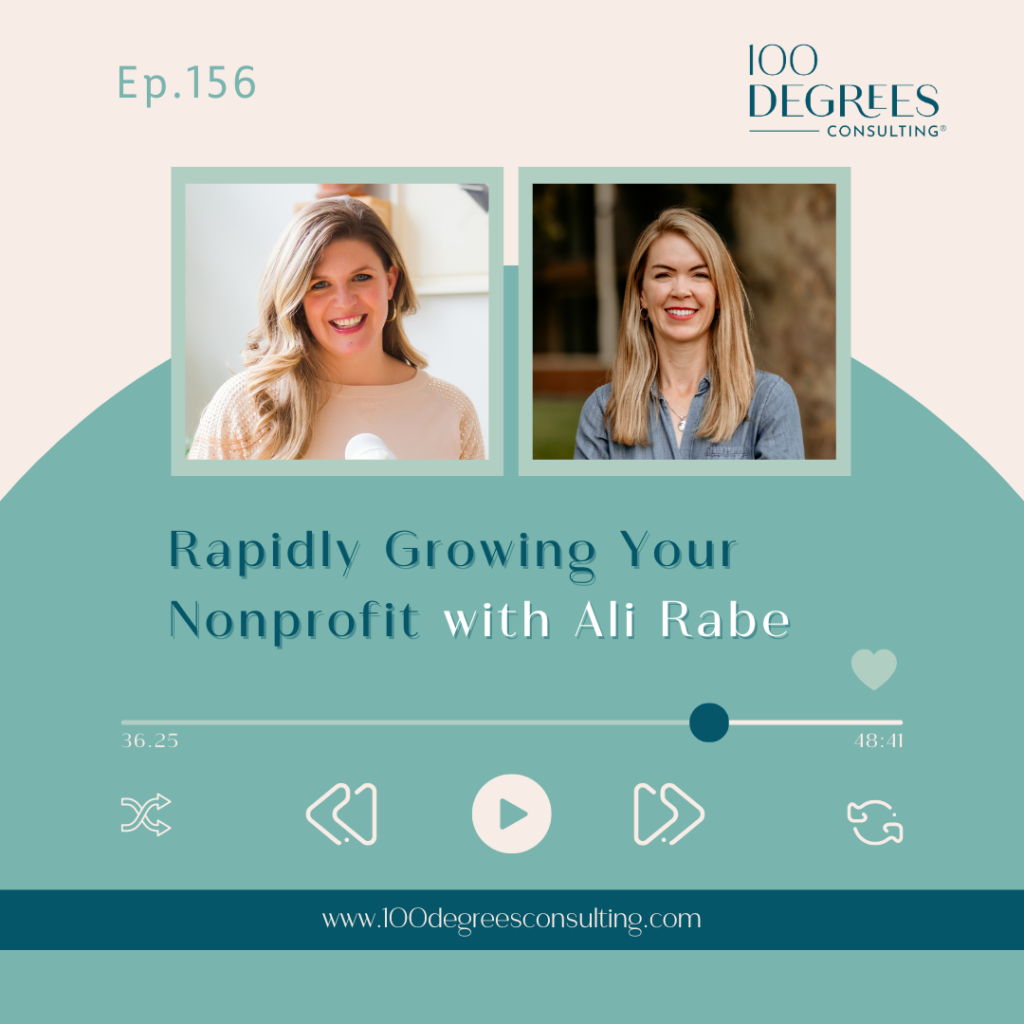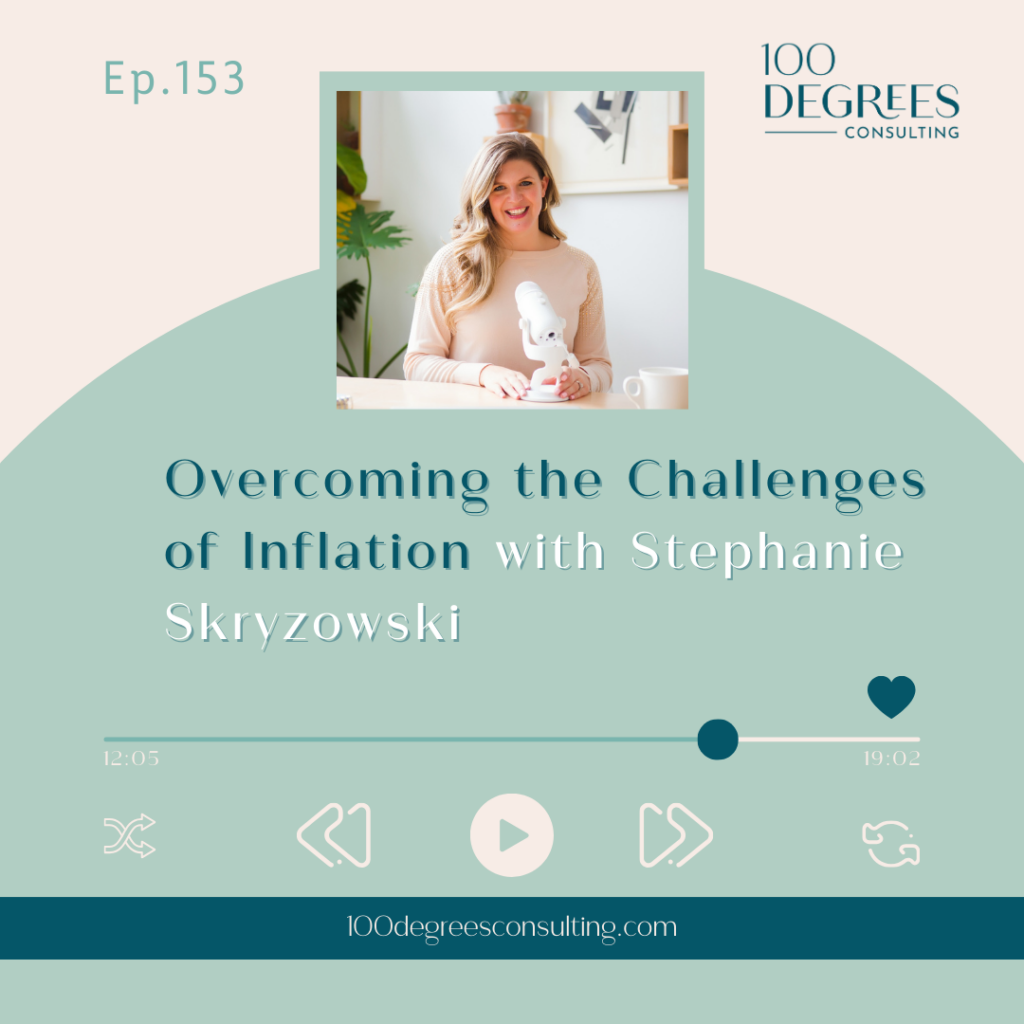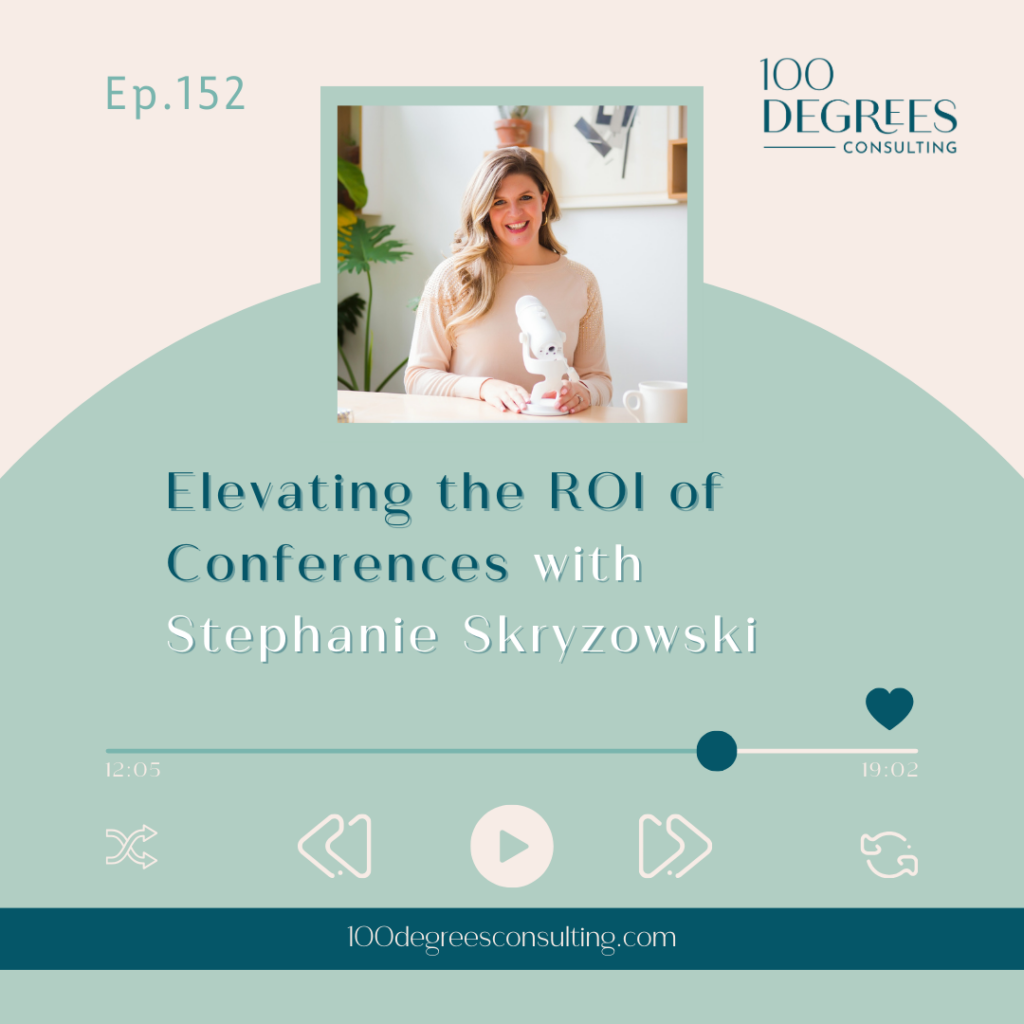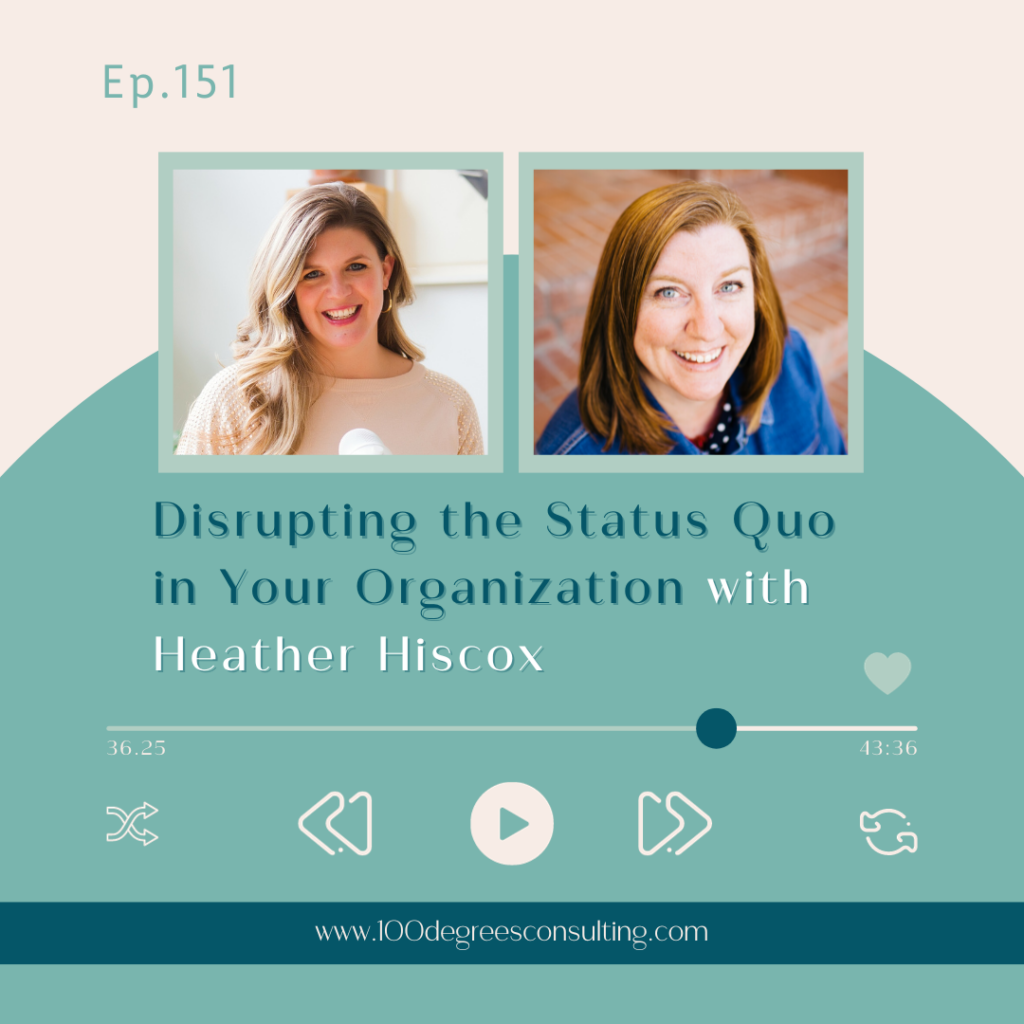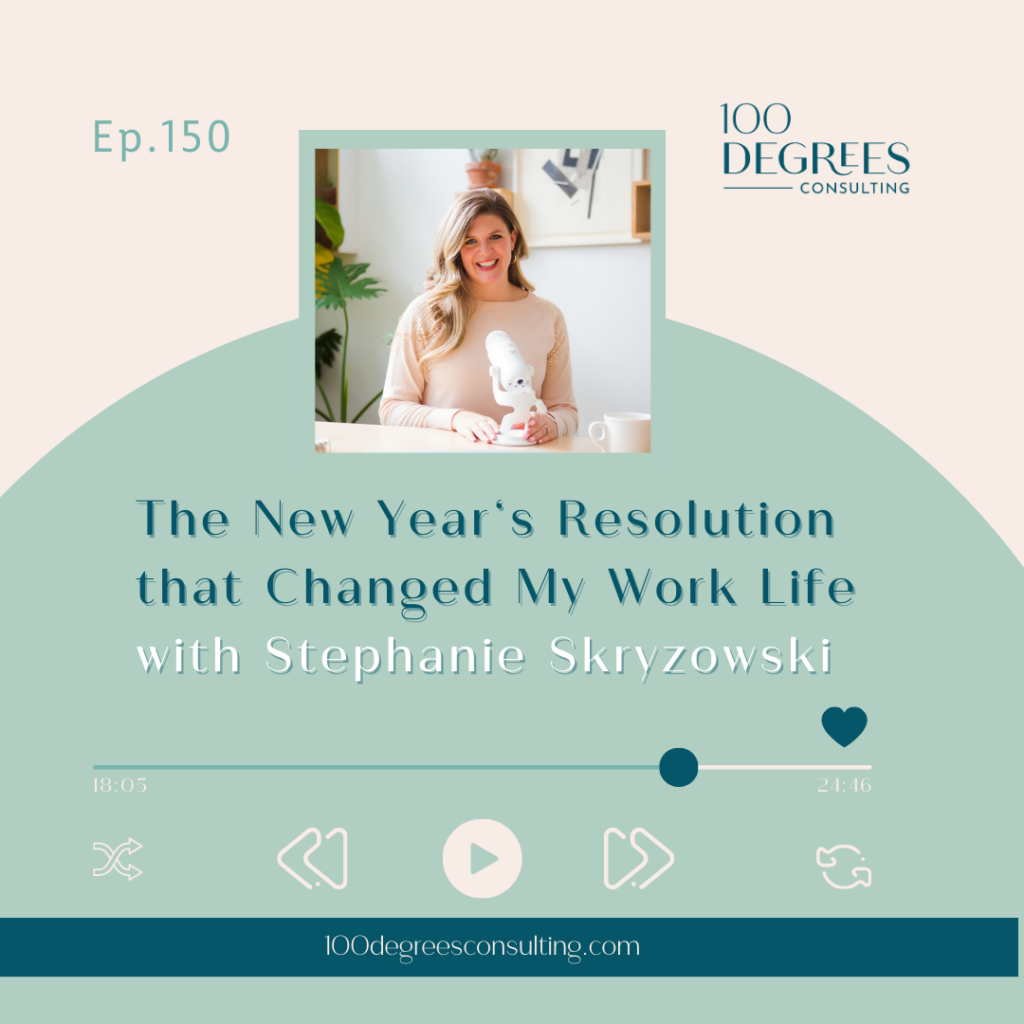Episode 47: My Hot Take on Profit First
Transcript Episode 47
Stephanie Skryzowski
Welcome to the 100 Degrees of Entrepreneurship Podcast, the show for purpose-driven entrepreneurs who want to get inspired to step outside of your comfort zone, expand it to your purpose and grow your business in a big way. I’m your host, Stephanie Skryzowski, a globe trotting CFO whose mission is to empower leaders to better understand their numbers to grow their impact and their income. Let’s dive in!
Hey, friends, I am back! Welcome to 100 degrees of entrepreneurship, and I am Stephanie. I’ve got a hot episode for you today, I am really excited to talk to you about Profit First.
So, Profit First is a book written by a guy named Mike Michalowicz. It is incredibly popular in the online business space, in the small business entrepreneurship space, because it gives a really clear, really easy to understand framework for managing your business money. However, I love this book with a caveat. And I’m going to talk about the caveat today. Because it’s really interesting.
You probably have heard of this book, if you haven’t, I really strongly recommend you read it. It’s a super easy read and really practical advice, with lots of stories in it. So it’s not like a finance investing boring accounting book is quite interesting. So I’m going to explain to you today, sort of the core principles of Profit First. I am going to talk about how I use some of these principles in my business and how I encourage our clients to use some of these principles. And so let’s do it, let’s do it!
Profit First. So this concept Profit First was created by Mike Michalowicz, who worked with a ton of small businesses. He was basically seeing businesses who seem to be doing well, on the top line, right? Like revenue was decent, revenue was pretty good. But it was flying out the door as fast as it came in. And so these business owners were working themselves to the bone, and essentially had nothing to show for it because their business cost as much to run as the money that they brought in.
Mike Michalowicz created this methodology to ensure that you’re taking your Profit First, right? So the revenue comes in, you take your Profit First. Set that aside, and then, your expenses and paying yourself and all of that stuff comes after that. I love this concept, right? Because I think we all know the principle that you know, of time, especially that a task expands to the time you give it, right? So if you have three hours to finish a task, it’s going to take you three hours, if you have one hour to finish the task, it’s going to take you one hour.
Work expands to the time that you’re given, there’s like an actual quote around that, but you know what I’m talking about. So Mike found that the same thing was true with money, right? Like your business expenses are going to expand to the amount that you give them. So if you’re making $30,000 a month, and you’re allowing your expenses to just kind of do what they want, they’re gonna fill that $30,000. And you’re gonna be left like so many of the entrepreneurs that he talked to, with nothing to show for your hard work, okay? So that’s where this whole concept comes from.
You may be thinking, “Oh, my gosh, this sounds like me.” If this sounds like you, run, don’t walk. Go to Amazon. Go to your local bookstore. Grab a copy of Profit First, it is really, really useful.
Basically, the sort of the idea behind Profit First is taking your revenue. This is your money coming in as a bucket. And in a bucket, I like to think of it as a bucket of cash, right? So you have this revenue, you have this bucket of cash, you’re going to take all of the money out of the revenue bucket of cash, and you’re going to put some of it into a few other different buckets.
You’re going to put some of it into a bucket for profit. This is the money that you set aside, and it is your profit. You are going to take money out of that revenue bucket, take a handful of cash and you’re gonna put it into an owners compensation bucket. So hey, that’s you, my friend! You need to pay yourself, have we talked about that yet?
You need to pay yourself in your business. If you’re not paying yourself, then we need to have a conversation. I had a client once who was making good money in her business, but was paying herself like $1,000 a month and grew to just be kind of resentful and like, “oh my gosh, I’m working so hard and like why aren’t things growing?” And I’m like, “Well, first of all, your business is making a couple 100 grand and you’re paying yourself a $12,000 salary like maybe that’s what you’re resentful of, right?” So, we got to make sure we are paying ourselves friends!
Okay, so back to the revenue bucket of cash. So now that you’ve put a handful of cash into profit, you’re putting a handful of cash into owners compensation. You’re putting another handful of cash into tax. A tax bucket. Yes, we need to save for taxes. If you’re not doing that, please start doing it. And then a handful of cash into operating expenses. And so that is like, all of the expenses, everything it costs to run your business.
Now, you might be thinking, How do I decide how much to put into each of those buckets? What if my tax situation is this, what if I need to make this to pay for my personal expenses? What if I don’t have enough or what if my operating expenses are higher? Okay, so in Profit First, this is why you need to go grab a copy of this book, he has a chart.
He has a nice little chart that tells you okay, if your revenue is from zero to $250,000 a year, here is the percentage of revenue that you need to put into the profit bucket, the owners compensation bucket, the tax bucket and the operating expense bucket. If you make 250 to $500,000 a year, here’s how much you’re going to put into each of those buckets as well. So he gives you some really good guidelines, which I love. I love a good benchmark!
I don’t know about you, but I love a guideline – I love something to strive towards. You understand the basic concept, right? We have this revenue that we are making. And we are then allocating it or putting it into four separate buckets, profit, owners compensation, tax, and operating expenses.
Now, he goes on to say that you need a different bank account for each of these buckets. So you need a bank account for all of your incoming revenue. And then, you need a different bank account for your profit, a different one for your compensation for your tax for your operating expenses. Because the idea behind this is like you need to visually see where your money is going. And so, theoretically, at the end of every month, that revenue bucket is going to be empty. Because you have moved everything out of there into each of those other four accounts or four buckets.
That’s the concept there. And then there’s more bank accounts, my friends, I think that’s like five bank accounts. So far, there’s more, I have to go back and figure out what the exact parameters are. But you also have a vault account, which is like a rainy day savings, do not touch account at a separate bank. A separate bank, my friends.
So he wants you to have a separate bank account and a separate bank. It’s your vault. It’s your “Do not touch,” it’s your cash reserve, your rainy day fund. And it’s over there, it’s hard for you to get to. And that’s the point of it, he wants it to be hard to access.
Then he also recommends that as part of the profit first system, every two weeks, you are making all the bank transfers, okay? So you are looking at your bank accounts, every two weeks, you’re looking at what came into your revenue account, and then you’re moving money from that revenue account into each of these other accounts. And then two weeks, again, the same thing happens, whatever’s in that revenue account, you’re then allocating into moving, literally transferring money at your bank, between all these different accounts.
And so the whole idea here is that you never run out of money. Can you imagine that? Like, I don’t know about you, if you have ever felt like, “oh my gosh, I’ve run out of money,” with the system. If it’s done, right, if you follow the percentages, the benchmarks that he gives you, you will never run out of money. You will always have enough money to pay your taxes. You will always be paying yourself something.
Now remember, these numbers are based on percentages. So if you have a really low revenue month, you’re gonna have a real low owners compensation month too. But theoretically, you will always pay yourself even if you made $10, you would still pay yourself like a buck or two bucks, you know, depending on the percentage.
I like the idea very much. I like that this gives a very clear methodology and process to business owners who otherwise would let their money fly out the door. And not on purpose, right? Like we’re not purposely wasteful or like not paying attention to our money, but it’s sometimes hard to manage. It’s hard to have that foresight into maybe what’s coming down the road, right? If you don’t have a forecast, if you’re not really planning ahead for your money, and you’re just kind of like looking at your p&l from last month after it’s already happened, you can’t change anything anymore, then this is a really good methodology to help you just get a handle on your money, feel like you have a sense of control. And again, you will never run out of money with this method.
So we use this, especially the concept around some of these percentages with many of our clients. We have our finance workbook that we use with all of our clients. That manages their revenue and expense and cash forecast. We have some benchmarks in there for what their profit should be, what should be going into their tax savings account, where their operating expenses should be. And we are looking at that every single month.
Now, we are not like, “Uh-oh! You exceeded your percentage, like your business is a failure?” No, not at all. If our operating expenses are over, whatever profit first tells us or whatever benchmark we created, that’s okay. We just need to make sure we kind of get that back in line, right? So I don’t believe in like hard and fast rules, I believe in guidelines. And as long as we can kind of stay within that both, you know, month to month, but really for the year, then we’re in a good place. And so this is where our profit playbook comes in. So if you don’t have the profit playbook, listen up!
COMMERCIAL BREAK: You hear me talk all the time about how important it is to know your numbers as a business owner. But you may be thinking, well, how in the world do I do that? Where do I even begin? So, I have a free resource for you. The profit playbook is an amazing template that you spend about 15 minutes getting it all set up. And you can literally see into the future of your business revenue, expenses, cash flow, just like a crystal ball. It is a huge resource that will absolutely help you create a roadmap to reach your goals in your business. It is for free, over at 100degreesconsulting.com/profit
Okay, now that you have the Profit Playbook, basically what this gives you is an opportunity to lay out your revenue and your expenses for the year. And so then you have this vision into the future. So you can literally look into the future and look at these percentages for yourself.
So look at your revenue. Okay, so now you know what your revenue bucket is. Look at your operating expenses, how much does it cost to run your business? Okay, so Profit First is telling us, if you make zero to $250,000 a year, your operating expenses should be about 30% of your revenue. Okay, so let’s break this down. If you are making $10,000 a month. So you’re making on average 10 grand a month, your operating expenses should be about $3,000 a month.
Now, when you have the profit playbook, and you have kind of laid all of this out, you can really easily see like, okay, am I on track? Or like, oh my gosh, my expenses are $1,000 a month. Okay, maybe we have a little bit of a situation here, right? I love the benchmarks. I think this is great. When you download the profit playbook, you will see that we do have some benchmarks laid out on the bottom for you that are sort of are derived from profit first. So feel free to change those up. But I love having benchmarks.
Okay, here’s my hot take, here’s what I don’t like. Personally, the thought of having like eight different bank accounts, some of which are in a separate bank will make me crazy. Like that makes me go bonkers. So I don’t like that. I don’t like having multiple accounts. And I think that it can be helpful for some people, especially if you like to visually see how much is in each bucket, right? If you want to see, okay, I have $20,000 sitting in my tax bucket, okay, I have $30,000 sitting in my operating expense account. That’s great. Then set up all those accounts, by all means there’s nothing wrong with it. From a tax perspective, it doesn’t matter if you have as many accounts as you want.
For me, it’s way too much to manage. So what I do, and what I do really recommend is having at least two accounts, you 100% need two accounts at least. So your first account is a checking account. And you are using that for your money coming in, you’re using that for your expenses, anything you’re paying yourself. And then you have a savings account that you’re using for your taxes and your profit.
That is personally what I do. I have a checking account, I have a savings account. And for me, that’s enough. I have visibility into how much my monthly expenses are and how much I pay myself and all that stuff. So I don’t feel like I need all those different accounts. So that’s one hot tip I have is that I don’t think you need all those accounts. I see the value in it, especially if you’re super money and numbers averse, which I’m here for you, my friend. My heart goes out to you, I’m here for you. But if you feel super uncomfortable with it, it might help you to visualize that money a little bit more clearly in all those different accounts but is not for me.
Okay, and the second heartache I have is that Profit First recommends that you do these allocations every two weeks. That for me is way too much. Also, the way that I do my client billing, it’s just doesn’t work with that cycle. What I prefer to do is I wait until the end of the month after I have closed the book, so then I can officially see how much revenue I have. I can officially see that and Then I make my moves, then I make my transfers of money. So if I say, Okay, I made $10,000. Last month, I know I’m gonna put 1000 into the account for taxes, I’m gonna put 1500 in there for profit. And so let me move 2500 bucks from the checking account into the savings account. Boom, once a month done!
So I know people, we have clients that do this religiously, and do it every two weeks without fail. And that’s great that works for them, it doesn’t work for me. I don’t want to do it every two weeks, I want to do it every month, when I sit down to have my like, monthly finance date with myself. That’s when I do my money movements.
So again, if you’re one of those people that you’re like, “Ugh! You know, “I really don’t love money,” maybe setting up a bi weekly routine, where you’re hanging out with your cash every two weeks, that might be a better move for you.
That’s it, my friends, that is my take on Profit First, the good and the things that I don’t love that I just choose to do differently. I think there is a lot to take away from this book. If you haven’t read it, I highly recommend, like I said, go out to your local bookstore, grab this book, because it will potentially change the way that you manage money in your business. And if you haven’t already grabbed our profit playbook, because that only helps you get that much closer to managing your money really, really well in your business.
Again, what I love about Profit First is that you literally will never run out of money. So if that sounds good to you, I would definitely recommend reading this book, I should say I am in no way affiliated with Profit First. It’s just a conversation that I, number one and asked about literally all the time. And I talk about it all the time because I see so much value in this model. So no affiliation whatsoever, just sharing my thoughts on profit first.
I hope this was helpful. As always, you know where to find me. I’m over on Instagram. Catch me in the DMS. I’m @stephanie.skry and I’ll see you next time, friends.
Thanks for listening to the 100 degrees of entrepreneurship podcast. To access our show notes and bonus content, visit 100degreesconsulting.com/podcast. Make sure to snap a screenshot on your phone of this episode and tag me on instagram @stephanie.skry and I’ll be sure to share. Thanks for being here friends, and I’ll see you next time!
Transcript for Episode 47










